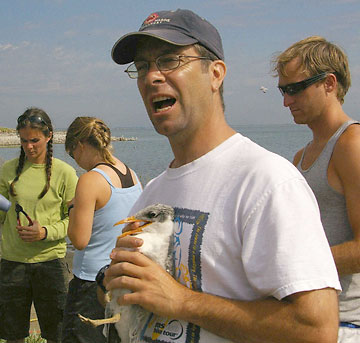COASST Chats with Tom Good, AKA the Gull Guy—Spring/Summer 2007
COASST: You’ve been working at the National Oceanic and Atmospheric Administration (NOAA) Northwest Fisheries Science Center (NWFSC) since 2001. Can you tell us a bit about what you do there?
Tom: My job title is fisheries biologist, but I think that ecosystem biologist is a more appropriate description of what I do because I work across a number of disciplines, only one of which is fisheries science. Currently, I am looking at the influence of avian predation on juvenile salmon in the mid-Columbia River.
COASST: So, what’s your opinion? Do seabirds have an impact on salmon populations?
Tom: Well, the impact varies from situation to situation. In the lower Columbia River, Caspian Terns and Double-crested Cormorants probably do influence salmon populations, but to what extent is hard to estimate. There are a lot of other factors involved, such as food supply, predation by other species, and human actions that might also account for changes in salmon populations.

As a Caspian Tern chomps on Tom's finger, he marvels at just how exciting field work with seabirds can be! (Courtesy of T. Good)
COASST: Have you always been interested in salmon?
Tom: Actually, my favorite animals to study are gulls. Before I worked for NOAA, I completed my Master’s at the University of New Hampshire, where I worked on gull diet. For my PhD, I traveled to the Pacific Northwest to do field work on Western and Glaucous-winged Gulls on Tatoosh Island and in Grays Harbor. Later, while I was doing my post-doctorate work at Brown University (on fruit flies of all things!), I was able to spend the summers studying Great Black-backed Gulls at Shoals Marine Lab, in Maine. At NWFSC, I still get to study gulls because they eat salmon.
COASST: Our director, Julia Parrish, also does a lot of fieldwork on Tatoosh. Have you guys ever worked together?
Tom: Definitely, Julia and I go way back. You could even say we laid the groundwork for COASST. Back in 1996, Julia and I decided that daily beached-bird surveys along the outer coast would be a great way to track seabird populations. Our surveys were conducted a little differently than they are today. In the first year, we used nail polish instead of cable ties to mark birds. By 1997, we noticed a huge spike in Common Murre carcasses corresponding to the El Niño event. It was an exciting time and many people in the Ocean Shores area took a real interest in our work. It’s neat because these same people went on to become some of COASST’s first volunteers.
COASST: Many COASST volunteers find that their passion for seabirds extends beyond their commitment to COASST. Are there seabirds in your personal life?
Tom: Of course! I take my binoculars everywhere I go to meetings, vacation spots, and the coast. Birds seem to mark many significant events in my life. In fact, my wife, Beth, and I got engaged on Tory Island, a seabird colony off the coast of Ireland. We were lying on the edge of a cliff, 100 m above the Atlantic, looking down at colonies of Northern Fulmars, Shags, and Atlantic Puffins nesting on the rocks below us. It was spectacular! A rock, known as the Wishing Stone, juts out over the edge of the cliff. Legend says that if you succeed in throwing three stones in a row from the cliff edge onto the flat stone, then you will be granted one wish. We both tried and when Beth asked me what I had wished for, I turned to her and told her that I wished she would marry me. She said yes.